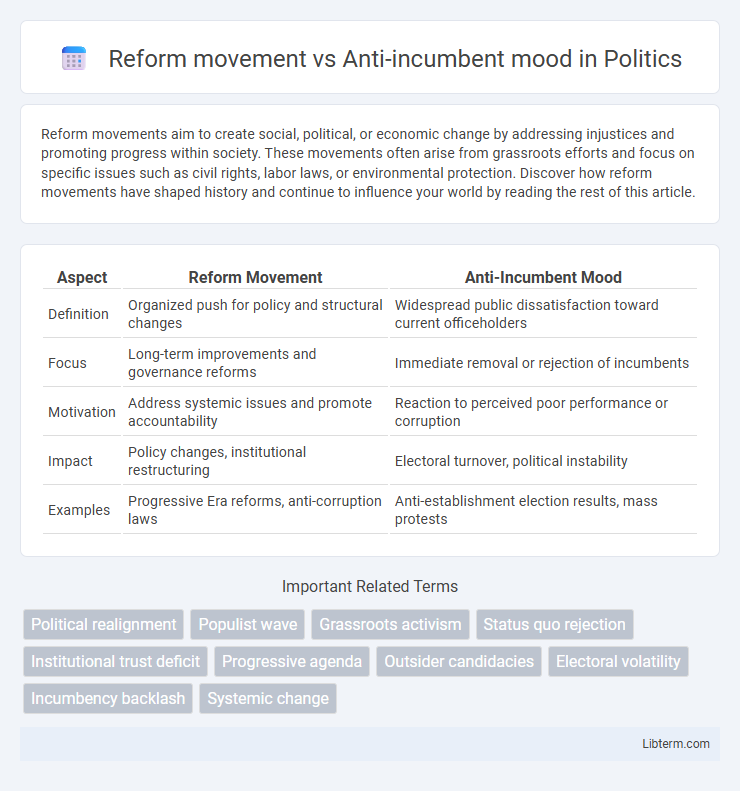Reform movements aim to create social, political, or economic change by addressing injustices and promoting progress within society. These movements often arise from grassroots efforts and focus on specific issues such as civil rights, labor laws, or environmental protection. Discover how reform movements have shaped history and continue to influence your world by reading the rest of this article.
Table of Comparison
| Aspect | Reform Movement | Anti-Incumbent Mood |
|---|---|---|
| Definition | Organized push for policy and structural changes | Widespread public dissatisfaction toward current officeholders |
| Focus | Long-term improvements and governance reforms | Immediate removal or rejection of incumbents |
| Motivation | Address systemic issues and promote accountability | Reaction to perceived poor performance or corruption |
| Impact | Policy changes, institutional restructuring | Electoral turnover, political instability |
| Examples | Progressive Era reforms, anti-corruption laws | Anti-establishment election results, mass protests |
Understanding Reform Movements: Definition and Examples
Reform movements are organized efforts aimed at making gradual changes to political, social, or economic systems to address perceived injustices or inefficiencies, exemplified by the Progressive Movement in early 20th century America that sought labor reforms and anti-corruption measures. These movements contrast with the anti-incumbent mood, which reflects widespread voter dissatisfaction leading to electoral turnover without necessarily endorsing specific policy changes. Understanding reform movements involves recognizing their structured goals and advocacy for specific legislative or institutional changes, as opposed to the broader, often reactionary nature of anti-incumbent sentiments.
What Fuels an Anti-Incumbent Mood?
An anti-incumbent mood is fueled by widespread public dissatisfaction with perceived government inefficiency, corruption, and failure to address pressing socio-economic issues, leading to diminished trust in established political leaders. Economic downturns, scandals, and unmet campaign promises intensify voter frustration, creating fertile ground for reform movements advocating systemic changes and new leadership. Media coverage and social media amplify public grievances, accelerating the erosion of incumbent support and empowering opposition candidates.
Key Differences: Reform Movement vs. Anti-Incumbent Sentiment
The Reform Movement centers on specific policy changes and institutional improvements aimed at addressing systemic inefficiencies, while Anti-Incumbent Sentiment reflects a general dissatisfaction with current officeholders regardless of policy specifics. Reform advocates seek structured solutions and often support new governance models, contrasting with Anti-Incumbent moods that primarily express voter frustration and desire for political turnover. The Reform Movement promotes targeted civic engagement, whereas Anti-Incumbent sentiment can lead to broad electoral volatility without clear policy direction.
Historical Origins of Reform Movements
Reform movements historically emerged during periods of widespread social dissatisfaction and political corruption, such as the Progressive Era in the early 20th century, which sought to address issues of inequality, labor rights, and government accountability. Anti-incumbent mood often arises as a reaction to prolonged political stagnation or scandals, reflecting public frustration with entrenched power rather than specific policy goals. The distinction lies in reform movements promoting structured change rooted in ideological principles, whereas anti-incumbent sentiment primarily functions as a short-term electoral backlash against existing officeholders.
Political Impacts of Anti-Incumbent Waves
Anti-incumbent waves significantly reshape political landscapes by increasing turnover in elected offices and reducing the influence of established politicians. These waves often fuel reform movements aimed at enhancing transparency, accountability, and responsiveness within government institutions. Consequently, anti-incumbent sentiment accelerates policy innovation and shifts power towards outsider candidates or emerging political groups.
Social Drivers Behind Reform Demands
Reform movements are fueled by social drivers such as economic inequality, lack of political representation, and widespread dissatisfaction with governance transparency. The anti-incumbent mood intensifies when communities experience stagnant wages, corruption, and unmet public service needs, prompting demands for systemic change. Grassroots mobilization and social media amplification amplify calls for reform by highlighting injustices and promoting alternative leadership models.
Anti-Incumbent Sentiment in Recent Elections
Anti-incumbent sentiment in recent elections has surged due to widespread public dissatisfaction with government performance, corruption scandals, and economic challenges. This mood often drives voters to favor challengers or outsider candidates promising change, resulting in high turnover rates for established politicians. Data from recent electoral cycles indicate a significant correlation between anti-incumbent attitudes and decreased approval ratings for sitting officials, impacting election outcomes profoundly.
Case Studies: Successful Reform Movements
Successful reform movements like the 1960s Civil Rights Movement and the 2011 Egyptian Revolution demonstrate the impact of grassroots mobilization against entrenched political incumbents. These movements harness public dissatisfaction, leveraging social media and mass protests to challenge established power structures effectively. Their outcomes include significant policy changes and shifts in political leadership, illustrating the potency of organized reform efforts amidst anti-incumbent sentiments.
Media’s Role in Shaping Public Mood
The Reform movement leveraged media outlets to highlight government inefficiencies and corruption, thereby amplifying public demand for change during periods of anti-incumbent sentiment. Investigative journalism and editorial campaigns played critical roles in framing political narratives that questioned the legitimacy of sitting officials. Media portrayal of political scandals and policy failures intensified voter dissatisfaction, directly influencing electoral outcomes and fostering reform agendas.
Future Outlook: Will Reform or Anti-Incumbency Prevail?
The future outlook indicates a complex interplay between reform movements advocating systemic change and the persistent anti-incumbent mood fueled by public dissatisfaction with current leadership. Political analysts predict that reform initiatives focusing on transparency, accountability, and policy innovation may gradually gain traction, especially as voters demand effective governance. However, episodic surges in anti-incumbency sentiment could continue to disrupt electoral stability, underscoring the need for incumbents to address core voter concerns proactively.
Reform movement Infographic

 libterm.com
libterm.com